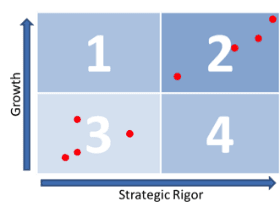
The futurist Alvin Toffler once said, “You’ve got to think about big things while you’re doing small things, so that all the small things go in the right direction.” This is the essence of a strategic plan. It aligns all the activities and resources of a business to achieve the “big things” the business wants to achieve. And, since every business is unique, so too is every approach to strategic planning. The question is, do some approaches work better than others and how can we best learn from various approaches to make a difference in our own companies?
Rather than delve into an academic study about strategic planning (there are dozens of excellent books that do this well), I decided to gather real-world anecdotes from CEOs of ten technology and management services firms in the federal contracting industry to see how they did strategic planning and learn what was and wasn’t working. The results were fascinating and offer practical advice about strategic planning tailored toward higher growth and market impact.
Let me begin by making two important points. First, while there is clearly more to a company’s success than its mere possession of a strategic plan, I would argue that success may not be achievable without one. While good leadership, financial management, governance, intellectual property, and maybe even a bit of good luck factor into a company’s success, I will argue that a deliberate strategic plan is critical. Few companies attain consistent success without one.
Second, for context, let me provide a definition of “strategy” as it applies to this discussion. Strategy is an actionable plan to achieve one or more business goals under conditions of uncertainty and competition. A typical business strategy includes: 1) articulation of goals, 2) determination of actions and resources needed to achieve those goals, and 3) mobilization/implementation. “Conditions of uncertainty” refers to the fact that market conditions, technology, and client needs shift constantly. In business, few variables remain static. Effective strategies take into account these continuously changing conditions. Also, business strategies do not exist in a vacuum – they recognize the competitive nature of markets and are designed to “win” against one or more competitors that may have similar business goals. Think “chess” as opposed to “mountain climbing.”
For this study, I sought specifically to examine companies that were beyond their start-up phase, but were not yet too big or inflexible to change. I met with ten companies that ranged in size from roughly 100 to more than 500 employees drawing annual revenues of $15M to well over $100M. All were privately owned, some had outside investors, and most had either Boards of Directors or Boards of Advisors. All the companies had been in business from 5 to 25 years and all focused solely or principally on the federal government market.
Below, I summarize key findings from the study and then share what I believe are key takeaways from the companies’ experiences. As an important note, I omitted the names of the companies and their CEOs to protect their privacy; however, I sincerely appreciate the time and thoughtful input from each of the executives I met with!
Key Findings:
- Perceived value of strategy – Executives held varying perceptions about the inherent value of strategic planning and its impact on actual business results. While some CEOs felt formal strategic planning was unnecessary and had little impact on the bottom line, others made a strong connection between their strategic plan and the actions that drove overall business performance.
- Need for a strategic plan – There were widely varying definitions of “strategy” and very different approaches to strategic planning and implementation. While some companies maintained both a strategic plan and an operating plan (budget and financial forecast), some linked the two and considered their operating plan to be their strategic plan. In other words, they tended to view strategy as a forward-looking financial plan. Also, while some had very structured approaches to strategic planning, conducting a formal exercise on a strict annual schedule, others opted for meeting periodically with senior managers to discuss strategy less formally, and only when they felt it was needed.
- Objectivity – There was a wide range in the objectivity and openness of strategic planning. While some companies relied mostly on the perspectives and experiences of their leadership team when crafting the plan, others felt it was important to bring in outside analysts and market experts to infuse a more objective perspective. Only a few companies brought in outside facilitators to actually lead the effort – most were instead led by the CEO him- or herself.
- Market Outlook – Interestingly, there was a high correlation between the level of “deliberateness” in the strategic planning approach and the overall market outlook from the company’s perspective. I asked each CEO to rate on a scale of 1 to 10 the market from the company’s point of view (e.g., quantity and quality of available contract opportunities for their company). Companies with a more deliberate and structured approach to strategic planning had a more optimistic view of both the current and future market than companies with a less deliberate approach.
Reviewing the notes from my conversations with these company leaders, some interesting patterns emerged. Below are what I believe to be the most important conclusions from this exercise.
 Strategic Planning Drives Growth – Companies fell along a broad spectrum in terms of their strategic rigor, ranging from those companies without strategic plans to those that maintained periodically updated strategic plans to those with “living” strategic plans that evolved as the market landscape changed. It turned out that companies that tended to be more rigorous about strategic planning also tended to be more focused and experienced higher resulting growth. Consider the following graphic that plots as red dots the rough position of the companies I interviewed (those for which I had usable data). Every company falls into either quadrant 2 (high growth/high strategic rigor) or 3 (low growth/low strategic rigor). While my sample set is small, it is noteworthy that not a single company falls into either high growth/low rigor or low growth/high rigor. In other words, every company that demonstrated a rigorous and deliberate approach to strategic planning also had above average growth, and those that were more casual about strategic planning showed lower or no growth.
Strategic Planning Drives Growth – Companies fell along a broad spectrum in terms of their strategic rigor, ranging from those companies without strategic plans to those that maintained periodically updated strategic plans to those with “living” strategic plans that evolved as the market landscape changed. It turned out that companies that tended to be more rigorous about strategic planning also tended to be more focused and experienced higher resulting growth. Consider the following graphic that plots as red dots the rough position of the companies I interviewed (those for which I had usable data). Every company falls into either quadrant 2 (high growth/high strategic rigor) or 3 (low growth/low strategic rigor). While my sample set is small, it is noteworthy that not a single company falls into either high growth/low rigor or low growth/high rigor. In other words, every company that demonstrated a rigorous and deliberate approach to strategic planning also had above average growth, and those that were more casual about strategic planning showed lower or no growth.
- Thinking Strategically – While it’s better to have a strategic plan than not to, a well-crafted plan paired with strategic thinking drives the highest and most sustainable growth. Companies that think strategically frequently adapt their strategic plans as “living documents” and they are deliberate about having written business goals and action plans that are clearly communicated to all employees and stakeholders. They also recognize the benefit of the journey – the strategic planning process itself. It forces companies to periodically study their market, their competition, and their own strengths and weaknesses. As a result, they are more objective, collaborative, and open, and they learn to leverage their strengths and bolster their weaknesses. They welcome fresh ideas, constructive criticism, outside perspectives – and they involve multiple levels of management as well as outside advisors in their strategic planning, not just the C-suite. They also link where and how they focus their company’s resources and efforts to their strategic plans, creating strong alignment across all of the company’s activities. And their results are different. Companies that think strategically have higher sustained growth than those that don’t.
- Deciding What Not To Do – The most successful companies use their strategic plans not only to decide what to do, but just as importantly, what not to do. Strategic companies have the discipline to make hard decisions. They use strategic planning to shift their investments and resources from low-yield (but often long-standing) activities to activities that are most directly aligned with achievement of the company’s most important goals. This is difficult for many energetic entrepreneurs who by their positive nature see potential upside in nearly every opportunity and often dilute their efforts across too many fronts.
- Connecting the Strategic Plan – The highest performers connect their strategic plans from above and below. What does this mean? A strategic plan that is connected from above is one that is consistent with the company’s overarching mission, vision, and values. To be connected from below a plan must be linked directly to detailed performance management systems and incentives, to specific opportunity decisions and strategies, and even to daily conversations. The strategic plan is specifically the mechanism that creates clear and consistent alignment between the day-to-day actions of a whole company and achievement of its overall mission.
- Understanding the Market – Companies that conduct periodic structured strategic planning exercises have a better understanding of their markets and are therefore more optimistic about their future prospects. They take the time to study their clients and they anticipate their clients’ evolving business needs. They build offerings and solutions that are better connected with the market’s anticipated trajectory rather than just with where it’s been. The value of this connection between what a company does day in and day out and what clients need most cannot be overstated – it underpins the success of the fastest growing companies.
The overarching message coming from these discussions is clear. Companies that are more deliberate, structured, and disciplined about their approach to creating and implementing corporate business strategies are experiencing more success in a challenging market.
About the Author: Steve Tolbert is a business leader and growth strategist in the federal management and information technology services industry and formerly was senior vice president of the Health and Civil Sector at SRA International. He can be reached at: steve@stevetolbert.com.


